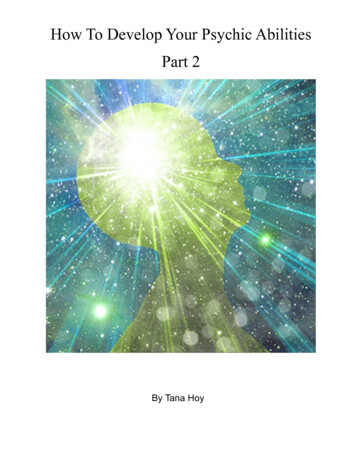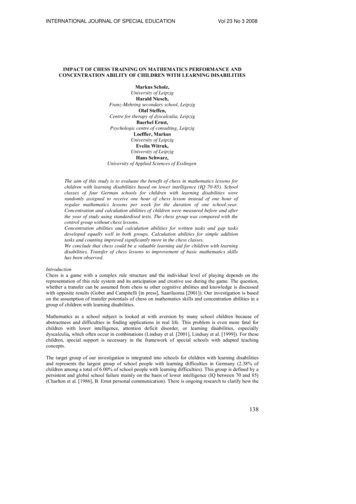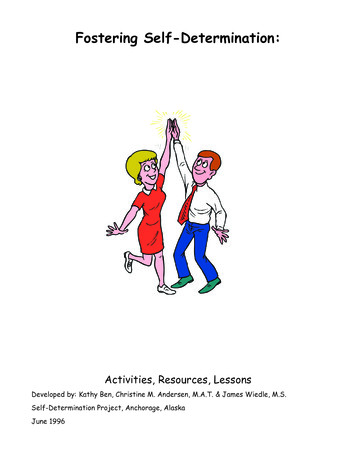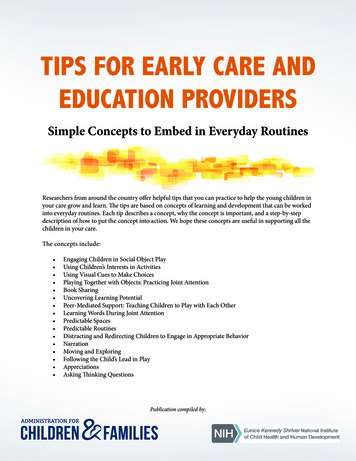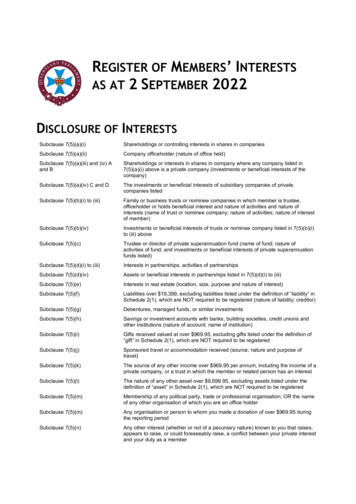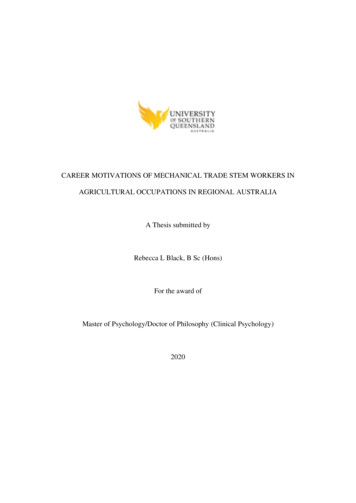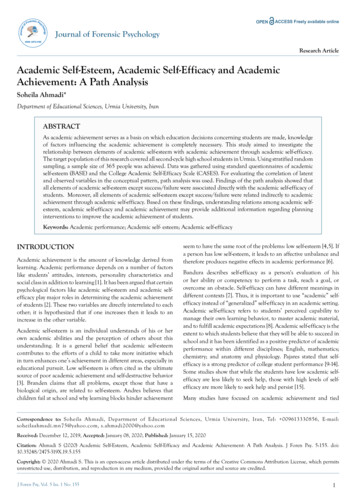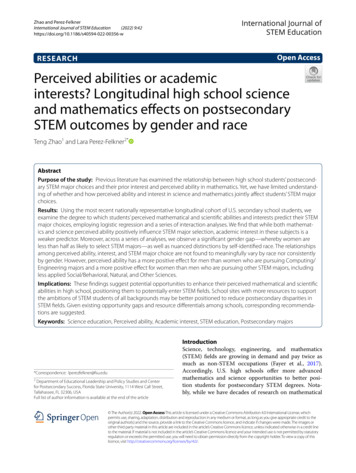
Transcription
Zhao and Perez‑Felkner International Journal of STEM Education(2022) rnational Journal ofSTEM EducationOpen AccessRESEARCHPerceived abilities or academicinterests? Longitudinal high school scienceand mathematics effects on postsecondarySTEM outcomes by gender and raceTeng Zhao1 and Lara Perez‑Felkner2*AbstractPurpose of the study: Previous literature has examined the relationship between high school students’ postsecond‑ary STEM major choices and their prior interest and perceived ability in mathematics. Yet, we have limited understand‑ing of whether and how perceived ability and interest in science and mathematics jointly affect students’ STEM majorchoices.Results: Using the most recent nationally representative longitudinal cohort of U.S. secondary school students, weexamine the degree to which students’ perceived mathematical and scientific abilities and interests predict their STEMmajor choices, employing logistic regression and a series of interaction analyses. We find that while both mathemat‑ics and science perceived ability positively influence STEM major selection, academic interest in these subjects is aweaker predictor. Moreover, across a series of analyses, we observe a significant gender gap—whereby women areless than half as likely to select STEM majors—as well as nuanced distinctions by self-identified race. The relationshipsamong perceived ability, interest, and STEM major choice are not found to meaningfully vary by race nor consistentlyby gender. However, perceived ability has a more positive effect for men than women who are pursuing Computing/Engineering majors and a more positive effect for women than men who are pursuing other STEM majors, includingless applied Social/Behavioral, Natural, and Other Sciences.Implications: These findings suggest potential opportunities to enhance their perceived mathematical and scientificabilities in high school, positioning them to potentially enter STEM fields. School sites with more resources to supportthe ambitions of STEM students of all backgrounds may be better positioned to reduce postsecondary disparities inSTEM fields. Given existing opportunity gaps and resource differentials among schools, corresponding recommenda‑tions are suggested.Keywords: Science education, Perceived ability, Academic interest, STEM education, Postsecondary majors*Correspondence: lperezfelkner@fsu.edu2Department of Educational Leadership and Policy Studies and Centerfor Postsecondary Success, Florida State University, 1114 West Call Street,Tallahassee, FL 32306, USAFull list of author information is available at the end of the articleIntroductionScience, technology, engineering, and mathematics(STEM) fields are growing in demand and pay twice asmuch as non-STEM occupations (Fayer et al., 2017).Accordingly, U.S. high schools offer more advancedmathematics and science opportunities to better position students for postsecondary STEM degrees. Notably, while we have decades of research on mathematical The Author(s) 2022. Open Access This article is licensed under a Creative Commons Attribution 4.0 International License, whichpermits use, sharing, adaptation, distribution and reproduction in any medium or format, as long as you give appropriate credit to theoriginal author(s) and the source, provide a link to the Creative Commons licence, and indicate if changes were made. The images orother third party material in this article are included in the article’s Creative Commons licence, unless indicated otherwise in a credit lineto the material. If material is not included in the article’s Creative Commons licence and your intended use is not permitted by statutoryregulation or exceeds the permitted use, you will need to obtain permission directly from the copyright holder. To view a copy of thislicence, visit http:// creat iveco mmons. org/ licen ses/ by/4. 0/.
Zhao and Perez‑Felkner International Journal of STEM Education(2022) 9:42ability and interest as predictors of postsecondary STEMoutcomes, limited research has directly assessed theinterplay and distinctions between these predictors. Evenless is known about science ability and interest, after decades of research focused particularly on mathematics.Early exposure to STEM-related courses can awakenstudents’ interests and lead them to postsecondarySTEM majors (Bottia et al., 2015). Advanced mathematics and science courses in high school have been foundto be essential to students’ opportunities to study STEMsubjects in college (Dalton et al., 2007; Schneider et al.,2013). Psychological factors, including interest, have beenfound to influence students’ pathways into these courses(Milesi et al., 2017; Perez-Felkner et al., 2017). Oftenregarded as a motivational variable and/or an affectivecomponent in educational psychology, interest has beenwidely studied as a mechanism that stimulates students’learning and academic achievement (Renninger & Hidi,2011; Renninger et al., 1992). However, we know lessabout how academic interests influence students’ postsecondary degree field. Self-assessed mathematics ability has also been found to affect students’ STEM majorchoices, even when students’ self-assessments of abilityare biased by sociocultural norms around who belongs inthese fields (Beyer, 1990; Correll, 2001). Interest is similarly socially conditioned (Watt et al., 2012). Complicating these educational metrics of self-assessed ability andinterest in science and mathematics are the complexsocioeconomic, racial, and gender dynamics currently atplay in secondary and postsecondary education. Socioeconomic inequality by race and gender remains a majorsocial problem, even among college graduates (Doren &Lin, 2019; Pais, 2011). Since STEM degrees can lead tohighly paid jobs, one would expect STEM professions toattract underrepresented students and women who areincreasingly the primary earners in their family. However, racial and gender disparities continue to persistin these fields (Carter et al., 2019; Saw et al., 2018; Xieet al., 2015). Importantly, gender differentials in postcollege earnings appear to be meaningfully explained inpart by postsecondary degree field (Bobbitt-Zeher, 2007;Xu, 2015; Zhang, 2008). Whether this is also the case forracial disparities remains unclear.Given the persistent gender and race disparities inWhite- and male-dominant STEM fields, despite extensive investment in broadened access and a changingeconomy, we examine a contemporary cohort comprisinga full range of socioeconomic, racial, and gender demographics with a focus on both mathematics and sciencepredictors of STEM postsecondary education. Using theNational Center for Education Statistics’ most recent longitudinal data, High School Longitudinal Study of 2009(HSLS: 09), this study investigates (1) the distinct effectsPage 2 of 26of mathematical and scientific interests and ability beliefson STEM major choice; (2) whether interests or abilitieshave stronger effects on students’ STEM major choice;(3) specific effects by students’ self-reported gender andracial identity, and (4) whether these patterns differ in bySTEM major cluster, with specific attention to Computing/Engineering majors.Literature reviewDisparities in U.S. postsecondary STEM educationand beyondThere are clear gender and racial disparities in STEMpostsecondary educational outcomes (e.g., Griffith, 2010;Huang et al., 2000; Shapiro & Sax, 2011). Riegle-Crumband Peng (2021) found that gender differences in postsecondary major choice can be shaped by societal stereotype and self-beliefs about mathematics ability. Students’pathways to STEM degrees may differ among students bygender and race (Ireland, et al., 2018). Using an intersectional approach, Nix and Perez-Felkner (2019) found thatBlack women and men experience especially strong gainsfrom positive mathematics ability beliefs and—after controls—are the most likely to declare mathematics-intensive STEM majors and earn degrees in these fields.Historically, Black, Latina/o/x, and Native Americanstudents have been characterized as underrepresentedgroups in STEM disciplines (Estrada et al., 2016; Maltese & Tai, 2011). Yet, racially minoritized students suchas Black and Latina/o/x youth were more likely to majorin certain STEM disciplines than their White peers whenusing multivariate analyses to account for explanatoryfactors such as secondary school course preparation andpostsecondary enrollment (Nix & Perez-Felkner, 2019),and racial differences are effectively null when focusing on the population of students who enroll in college(e.g., Riegle-Crumb & King, 2010). This is not the case forgender, where disparities remain among the U.S. postsecondary student population. Such research supportsthe value of ongoing investigation into the mechanismswhich might explain STEM postsecondary major selection, as it varies by gender and race (see Garrison, 2013;Riegle-Crumb, King, et al., 2019; Riegle-Crumb, Morton,et al., 2019; Xu, 2016).Studies using nationally representative, longitudinal data on U.S. cohorts of students have advanced ourunderstanding of these patterns; these data follow students from secondary school through postsecondaryeducation and workforce entry. In Griffith’s (2010) analysis of National Education Longitudinal Study of 1988(NELS: 88) and National Longitudinal Study of Freshmendata, White and male students comprised higher sharesof those persisting in STEM disciplines when comparedto underrepresented groups and women. Secondary
Zhao and Perez‑Felkner International Journal of STEM Education(2022) 9:42STEM course completion can explain much of the racegap in STEM postsecondary outcomes, including STEMmajor choice (Tyson et al., 2007) and entry into specificmathematics-intensive STEM major clusters (see e.g.,Riegle-Crumb & King, 2010; Perez-Felkner et al., 2014)such as Computing and Engineering fields.These studies did not however assess the effects of science ability beliefs nor closely attend to interest in science. This is now possible with the newest U.S. nationalcohort: the High School Longitudinal Study of 2009(HSLS: 09), which traces students from secondary schoolthrough postsecondary degrees. To reduce demographicinequality of opportunity to enter STEM career fields, itis crucial to understand the factors that may affect students’ STEM major choices, which may lead them to aSTEM career.Contextual factors influencing selection of STEMand Computing/Engineering majorsIn recent years, a steady flow of research has highlightedfactors that may affect students’ STEM major selection(Shapiro & Sax, 2011; Wang, 2013a). In addition to thedemographic characteristics discussed above, socioeconomic characteristics such as parental occupation andeducational background also positively predict postsecondary STEM outcomes (Wagner et al., 2002). Forinstance, Oguzoglu and Ozbeklik (2016) found in the1979 National Longitudinal Study of Youth that girlswhose fathers who were employed in a STEM profession were more likely to choose a STEM major in college,if they had no male siblings. In addition, family incomewas one of the components of family socioeconomic status that was used in predicting students’ STEM majorchoices (Niu, 2017). High-demand and high-earningfields such as Computing and Engineering may be especially attractive to students from less socioeconomicallyadvantaged families, as compared to less applied andhigh-earning scientific fields.Looking further into specific major fields such as Computing and Engineering vs. applied and non-appliedHumanities and Social Science fields, Wiswall and Zafar(2015) found that variations in individual beliefs aboutability in each major affect students’ major intentions,exacerbating the gender gap in major choices. Different majors tend to have distinct associations with abilities. Focusing on mathematics-intensive majors, Nix andPerez-Felkner (2019) found that 12th grade girls’ perceptions of their ability with difficult mathematics increasedtheir likelihood of choosing mathematically intensivemajors such as engineering and computer sciences overbiology and social/behavioral science majors. Dika andD’Amico (2016) also found that students’ perceivedpreparation in math could significantly predict students’Page 3 of 26persistence in these majors. Notably, in the fields of Computing and Engineering, women have remained distinctlyunderrepresented (Corbett & Hill, 2015). Thus, this studydigs further into these fields specifically.The demographic characteristics of students’ schoolsare also commonly included as covariates in statisticalmodels in prior research that examine students’ STEMmajor choices, such as high school type (e.g., Wang,2013a) and urbanicity (e.g., Legewie & DiPrete, 2014).Quadlin (2017) used the 1997 National LongitudinalStudy of Youth cohort and found that students fromless economically advantaged family backgrounds hada higher probability of majoring in applied non-STEMfields such as business, communications, and education disciplines as compared to higher-income families.Generally, private high schools offer more advancedmathematics and science courses and have a higher socioeconomic and college preparatory profile (Lee et al.,1998). As such, students in private schools are betterpositioned for postsecondary STEM majors and STEMcareers (Ketenci et al., 2020). School urbanicity matters as well. Rural students have been found less likely tocomplete advanced science courses than those in urbanschools (Perez-Felkner et al., 2014). Bottia et al. (2018)found that rural high schools were less likely to haveSTEM-focused programs, which could positively affectstudents’ postsecondary major intentions.In sum, it seems important to consider these contextual factors which may affect students’ pathways intoSTEM disciplines, during and beyond high school. Wang(2013b) found a stronger effect of math self-efficacy on2-year college students’ STEM interests than on 4-yearcollege students. Phelps et al. (2018) found that students’STEM major enrollments differed at 2-year and 4-yearcolleges (e.g., mechanical technologies vs. engineeringand engineering technology, respectively), within if notbetween major clusters such as Computing/Engineeringfields. Gender differences in U.S. students’ attainment ofNatural/Engineering Sciences and Life Sciences majorshas also been found to vary by college type, after controlling for additional characteristics such as college STEMGPA and academic and social integration (Perez-Felkneret al., 2019). Following these discussions of the value ofexplaining disparities in postsecondary STEM majorselection and contextual explanations, we turn to developmental and social psychological frameworks, whichare the focus of our study.Theorizing postsecondary STEM major choicePsychological theories have been adapted to explain students’ pathways from earlier educational experiencesthrough postsecondary STEM outcomes, includingmajor selection. This manuscript focuses especially on
Zhao and Perez‑Felkner International Journal of STEM Education(2022) 9:42Page 4 of 26Fig. 1 The conceptual model for this studystudents’ perceived abilities and interests in mathematicsand science. We also considered complementary theorywhich attends to the motivational relationships betweenstudents’ (1) expectations for success and (2) subjectivetask values; expectancy task-value theory postulates thatindividuals’ achievement-related choices (such as postsecondary majors) are associated with their confidencein specific subject domains, such as mathematics andscience (Eccles & Wigfield, 2002). Subjective task valuehas been further categorized into four subcomponentsincluding intrinsic value—the enjoyment obtained fromparticipating in these tasks (Eccles & Wigfield, 2002).In turn, college students may be more likely to choosethe majors in which they feel more efficacious and interested. This may be especially true for students fromunderrepresented backgrounds who typically receive lessencouragement and support in their pursuit of STEMdegrees. Using an older cohort of U.S. longitudinal data,Perez-Felkner et al. (2017) also found that perceivedmathematical ability affects science course enrollmentin secondary school, which in turn has consequences forpostsecondary major choice. Measures for science abilitywere not available in their study. However, students withhigher perceived mathematical abilities were found morelikely to declare STEM postsecondary majors. Perceivedmathematical abilities had particularly positive effectson the probability of Black girls’ and boys’ selection ofmathematics-intensive STEM majors and completingdegrees in these fields (Nix & Perez-Felkner, 2019).There has been more limited attention to how mathematics and science interest may affect students’ STEMmajor choice, despite academic interest being an important concept in educational psychology (Renninger et al.,1992). Therefore, this study examines whether interest—in conjunction with other established factors—predictsthe likelihood of majoring in STEM fields and demographic disparities in these outcomes. This study willalso assess students’ perceived ability in mathematics—already shown to affect postsecondary STEM pathways—and science, a crucial but under-examined domain.Conceptual frameworkThis study develops a framework which integrates Bandura’s (1977) self-efficacy, Hidi and Renninger’s (2006)interest development model, and Eccles et al. expectancy-value theory (Eccles, 1983; Eccles & Wigfield,2002), while accounting for prior literature on factorspredicting students’ STEM major choices. In this model(see Fig. 1), students’ intent to choose a STEM major isinfluenced by their perceived mathematical and/or scientific abilities, mathematical and/or scientific interests,parental education and occupations, high school andclassroom characteristics, which may stimulate students’
Zhao and Perez‑Felkner International Journal of STEM Education(2022) 9:42STEM motivation. This study presents a detailed explanation of the model’s theoretical grounding.Ability‑related perceptions and beliefsPostsecondary STEM majors require strong foundationalknowledge of mathematics and science. High schooladvanced mathematics and science courses can signalpreparedness to enter college in general and to enterpostsecondary gateway courses to STEM majors specifically (Schneider et al., 2013; Tyson et al., 2007). Thesecourses also have implications for students’ perceivedmathematical ability, including how girls and underrepresented students’ self-assessments of their ability may beshaped by in these gendered course and school contexts,with implications for entry to STEM majors (Correll,2001; Perez-Felkner et al., 2014).Bandura’s (1977) self-efficacy model emphasized anindividual’s belief in their innate capacity to achieve aparticular goal. When individuals realize that their abilities may not enable them to accomplish certain goals,they may give up. The concept of self-efficacy has beenwidely used in education research. Zimmerman et al.(1992) found that students’ perceived academic self-efficacy significantly affects their educational goal setting.Bandura (1993) illustrated that self-efficacy could befunctioning in the academic field through four major processes, including motivational and selection processes.Students’ beliefs in their efficacy played an importantrole in regulating their academic activities and aspirations, as well as their motivation directly. Later, Banduraet al. (2001) demonstrated that children’s self-efficacycould be more decisive in shaping their occupationaldecisions than actual academic achievement, which inturn indirectly influences students’ major choices. Therefore, self-efficacy is connected to goal setting as well asmotivation and/or aspiration, thereby influencing students’ STEM-related experiences in secondary school.In turn, building on Bandura’s concept of self-efficacy,perceived mathematical and scientific abilities may eachshape high school students’ pursuit of STEM degrees incollege towards the particular goal of majoring in STEMfields. We assess students’ perceived abilities holisticallyas described further in the methodology, encompassingself-assessments of ability on specific tasks (tests, assignments, difficult textbook material) and with their mathematics/science course and the discipline more generally,during their first high school year of study in these crucial subjects for future STEM majors.Interest developmentHidi and Renninger’s (2006) Four-Phase Interest Development Model illustrates how a person’s interest influences their attentions, goals, and levels of learning,Page 5 of 26which may contribute to academic motivation and/oraspiration. Hidi and Harackiewicz (2000) identify interest as a crucial motivational variable that affects students’academic performance. Thus, if students have strongerinterest in mathematics and science, they may be morelikely to have better mathematics and science performance and/or ability, potentially influencing their STEMchoices.According to Hidi and Renninger’s model, interest iscategorized as situational or individual. Situational interest is a temporary interest aroused by specific activities,while individual interest is a relatively stable interest(Schiefele, 2009). Situational interest can develop intoindividual interest, where a person’s subsequent decisions/behaviors are associated with this well-developedinterest. Notably, scholars have argued that individualinterest is not exclusively generated by the individual(Csíkszentmihályi et al., 1993); School actors such aspeers and teachers may affect the formation of welldeveloped individual interest. Frenzel et al. (2010) foundstudents’ development of mathematics interest waspositively associated with classroom characteristics likemathematics teacher enthusiasm. Therefore, students’classroom experiences with their mathematics and science teachers may also affect their interests in theseareas.Research questions and hypothesesGuided by prior literature and the conceptual framework above, this study examines the influence of perceived abilities and interest in mathematics and scienceon students’ STEM major choice. Specifically, this studyaddresses the following four research questions:1. What is the relationship between postsecondary students’ STEM major choice and their perceived abilities and interests in science and mathematics in highschool?2. To what extent do perceived abilities and academicinterests in science and mathematics distinctly predict students’ STEM major choice?3. To what degree do these relationships vary by genderand/or race?4. To what extent do these patterns differ in predictingstudents’ choice of Computing/Engineering, OtherSTEM majors, vs. non-STEM majors?Students with higher perceived mathematical/scientific abilities may be more likely to choose STEM disciplines in college. Similarly, students who have highermath/science interests are more likely to choose STEMdisciplines. It is unclear whether perceived abilities oracademic interests are the stronger predictor of STEM
Zhao and Perez‑Felkner International Journal of STEM Education(2022) 9:42major choice. Research on perceived abilities and academic interest discussed above suggest that both couldpositively affect students’ corresponding choices. Giveninterest in developing interventions to enhance students’opportunities to enter and complete STEM majors, weare interested in which is a more effective predictor ofstudents’ selection of STEM majors. Additionally, weevaluate whether these relationships vary by gender andrace. Finally, we consider whether the analytic models aresensitive to alternate specifications of the dependent variable. We assess these relationships on a more nuanceddependent variable, which parses high-growth and highearning applied majors in technological fields (Computing and Engineering) as compared to other STEM andnon-STEM fields.MethodsData source, declarations, and participantsWe used restricted-use data from the newest nationallyrepresentative longitudinal U.S. cohort, the High SchoolLongitudinal Study of 2009 (HSLS: 09). The NationalCenter for Education Statistics (NCES) followed incoming ninth-grade students through secondary and postsecondary education, beginning in fall 2009. Studentscompleted follow-up surveys in spring 2012 when themajority were in eleventh grade and at the transitorypoint from secondary to postsecondary education in2013, to collect information like college plans and choicesafter high school completion (Duprey et al., 2018; Ingelset al., 2014). An additional follow-up survey was administered in spring 2016. Beyond these surveys, federal datafrom other sources was incorporated into the restricteduse HSLS dataset by NCES and is acknowledged whereappropriate in the table source information we reportin the main paper and appendix. Public use access tothese data is available through the NCES website, as isthe application for restricted-use data, such as we usedfor these analyses: https:// nces. ed. gov/ surve ys/ hsls09/ hsls09 data. asp. Statistical code generated to analyzesupporting the findings of this study are available fromthe corresponding author upon request.The base-year sample includes ninth graders from 940high schools across the country. Here and throughout,descriptive information is rounded to the nearest tenth inaccordance with NCES restricted-data licensing regulations. Parents, teachers, school administrators, and counselors were also surveyed. The base-year student surveyasked questions related to students’ perceived mathematical/scientific abilities and math/science interests aswell as their feelings about math/science teachers. Thebase-year parent survey collected information about students’ family characteristics. Students’ first-declared college major was gathered in the postsecondary follow-upPage 6 of 26student survey (see detailed variable descriptions Table 7in Appendix).The analytic sample represents the students who wereninth graders in Fall 2009 and were still college studentsin spring 2016. We restricted the sample to those whoattended postsecondary institutions. Because there aremissing cases associated with each analytic variable, weused multiple imputation to reduce nonresponse bias.After imputation, our final analytic sample yielded 11,560cases. To ensure generalizability to the U.S. student population and enhance external validity, we used panel strataand survey weights (w4w1stup1) and provided by HSLS:09 to address the complex stratified sampling design, andto adjust for unequal selection probabilities of sub-populations, consistent with the recommendations by Dupreyand colleagues (2018) for appropriate weights when analyzing multi-wave HSLS data.MeasuresThis section summarizes all the variables used in thehypothesized model (Fig. 1).STEM major The primary dependent variable in thisstudy represents whether a student chooses a STEMmajor, a dichotomous variable (1 first major is STEM;0 not STEM). According to the HSLS: 09 codebook,the source variable (X4RFDGMJSTEM) represents therespondent’s major or field of study as of February 2016.STEM designations follow the U.S. Department of Education’s (2010) Classification of Instructional Programs.We also developed and investigated an alternate threecategory specification drawn from related source variableX4RFDGMJ14Y, that breaks into STEM major clusters:(1) Computing/Engineering fields, (2) Social/Behavioral,Natural, and Other Sciences, and (3) non-STEM fields.Past research has shown Computing and Engineeringfunction distinctly from other scientific areas given thehigh earnings and growth associated with these appliedand mathematically intensive technological fields (seeCorbett & Hill, 2015; Scott, et al., 2015). The non-STEMcategory is identical across both groups, as indicated laterin Table 2 and Table 7 in Appendix.Perceived mathematical/scientific ability Multipleitems in the base-year student survey measured students’perceived ability. We identified seven items that includeability self-assessments and their reflection in their perceptions of themselves as a mathematics/science “person”; this scale is intended to richly and robustly reflectstudents’ perceived mathematical/scientific abilities (seeTable 8 in Appendix). Original items were all 4-pointLikert scale items, ranging from 1 (strongly agree) to 4(strongly disagree), which we reverse-coded for interpretability such that the items range from strongly disagree to strongly agree as they increase from 1 to 4. The
Zhao and Perez‑Felkner International Journal of STEM Education(2022) 9:42Cronbach’s reliability α for our perceived mathematicaland scientific ability scales are 0.89 and 0.87, respectively, indicating strong internal consistency among theseseven items (see Kline, 2013). As an additional robustness check, we assessed the correlations between ouroriginal scales for students’ perceived mathematical andscientific abilities and the NCES-provided measures ofmathematics self-efficacy (r 0.92, p 0.001) and scienceself-efficacy (r 0.70, p 0.001).1 More detailed information about these and subsequently discussed survey itemsis provided in Table 8.Math/science interest Similarly, mathematics and science interests were also measured by a series of items(details Table 9 in Appendix). Again, the original scoreon each item ranged from 1 to 4 (strong agreement)and 4 (strong disagreement). Two negatively wordeditems were found. We therefore reverse-coded thesemeasures, such that four indicates “strongly agree”, tobe consistent with high values meaning high interests.The Cronbach’s reliability α for the scales we generatedto represent mathematics and science interests are 0.78and 0.81, respectively. These three items thus representmath/science interest reasonably well, as reliability scoresof α 0.75 are i
school; SCi a vector of student i's high school/college information including school type, school's urbanicity, and college type; and CCi a vector of student i's class-room experiences with their mathematics/science teachers. e procedure of testing H1b is similar to the process when examining the eect of perceived abilities on stu-
